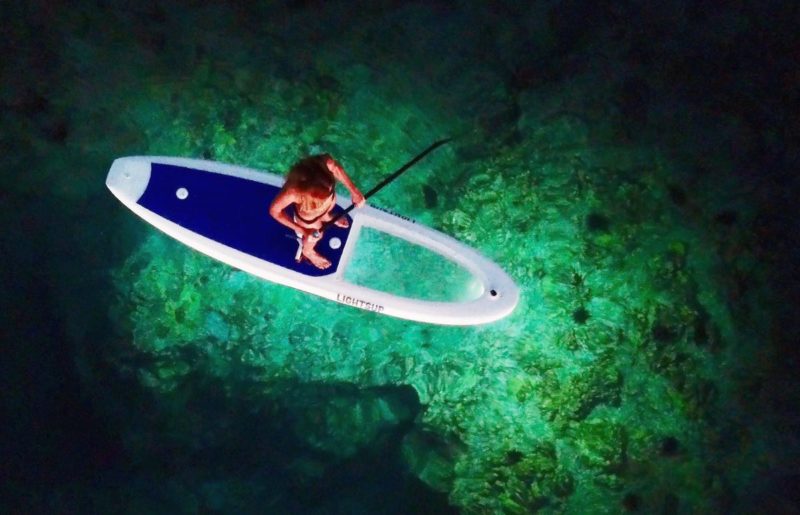Stand up paddle surfing (or SUP) is an emerging global sport with a Hawaiian heritage. It is called Hoe heʻe nalu in the Hawaiian language and is an ancient form of surfing that allows for a good view on the ocean, the incoming waves, the shoreline, and, if you are in the right place, the reef and ocean life below you.
Our Big Island SUP guide includes the following information:
Table of contents
- What is SUP?
- SUP Rentals + Classes in Hilo, Kona, south Kona and Waimea
- SUP Tours
- Paddle Tips + instruction video.
Table of Contents
- What is SUP?
- SUP Rentals + Classes in Hilo, Kona, south Kona and Waimea
- SUP Tours
- Paddle Tips + instruction video.
What is SUP and why do we like doing it?
A SUP board is larger than a surf board and measures between 9 and 12 feet or more in length. It has features such as a padded deck that make it easier to stay standing up and a concave hull. Because it is so large you can stand on the board without sinking, and you move yourself through the water with a paddle.
Stand-Up Paddling is a great way to leisurely explore the coastal waters around the Big Island, to look down at the colorful fish and corals, or to relax while checking out the tropical shoreline.
Finding and keeping your balance on a Stand-Up Paddling board is not trivial and gives a good core-body workout, but once you learn, the rewards are great!
SUP Lessons and Rentals on the Big Island
SUP is not as popular as surfing and your SUP rental options on the Big Island are still somewhat limited. We list here a few good surf shops that also rent SUP boards, and that can provide you with lessons and instructions.
SUP rentals and classes in Hilo
In Hilo, Hulakai (website) is a local company owned by Jun and Sarah. They offer SUP rentals on a daily basis and SUP lessons on an hourly basis. You can find them at 284 Kamehameha Avenue in Hilo, or reach them by phone at (808) 933-4852. Note that the lessons need to be reserved ahead of time.
SUP rentals and classes in Waimea
In Waimea you can find another shop of Hulakai (website). This one is located in the Mauna Lani shops, at 68 1330 Mauna Lani Dr. Suite 124. Their phone number is (808) 887-1091. SUP lessons here don’t need to be arranged ahead of time. Morning lessons are recommended as there often are breezy conditions in the afternoon.
Kona SUP rentals and lessons
In Kona (at the pier) KonaBoys are a trusted choice for SUP rentals and lessons.
If you are staying south of Kona should have a look at Kahaluʻu Bay Surf and Sea, 5 miles south of Kona. Like all other places, they offer both rental boards and SUP classes.
Paddle Board Tours
Guided SUP tours last a few hours and typically include SUP instruction (no experience needed!) and a snack or lunch. Tours often take you to special places with great views of fish, coral reefs, sea caves, and of course the shoreline.
If you are interested in a special SUP tour you should check out what LightSUP (based in Puako, close to Waialea beach) has to offer. Their boards have a large viewing window in front that acts as a kind of snorkeling mask which makes it really easy to see the reef and fish below the surface. To make it even better they have installed lights on each board so you can illuminate the ocean floor which makes for great views once the sun has set.

The SUP boards used for the tours organized by lightSUP have a large viewing window and lights installed making it really easy to see the reef and ocean life below you. Image credit: LightSUP
How to SUP? Tips + Instruction Video
If you have never stood on a SUP board before but want to try, out best advice to you is to pick a calm day and go on the water! You should get at least some instruction from your rental place of choice but we give you some good tips just we found helpful in case:
- Paddle with your core body, not with your arms! You have far more muscles in your core than in your arms, so using your body properly will let you SUP longer without getting tired.
- Falling is OK: We can guarantee you with 100% certainty that you will fall often when learning to SUP, and that’s OK! Learn how to fall properly (when in deep enough water!) to make sure you don’t bang the wrong parts of your body on the board to make the learning process easier. For example, fall away from and to the side of your board.
- Look at the horizon for best balance. Looking down will change the distribution of the weight on your board which makes it more difficult to stay standing up.
- Get away from the shore, but not too far! Close to the shore there are breaking waves, rocks close to the surface and other people: 3 thing you don’t want to be in/on with your SUP board. However, going *too* far out also isn’t a good thing: wind and ocean conditions can change rapidly and especially when you are a novice you don’t want to get in over your head. In summary: use common sense.
You can also have a look at the following video to understand the basics of Stand-Up Paddling: